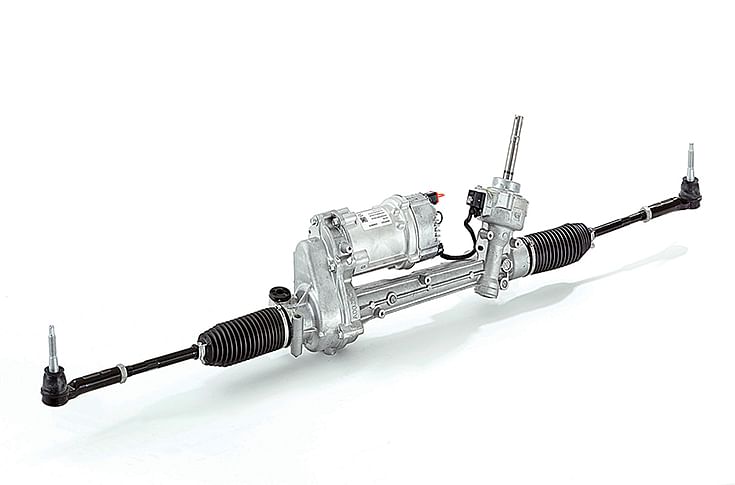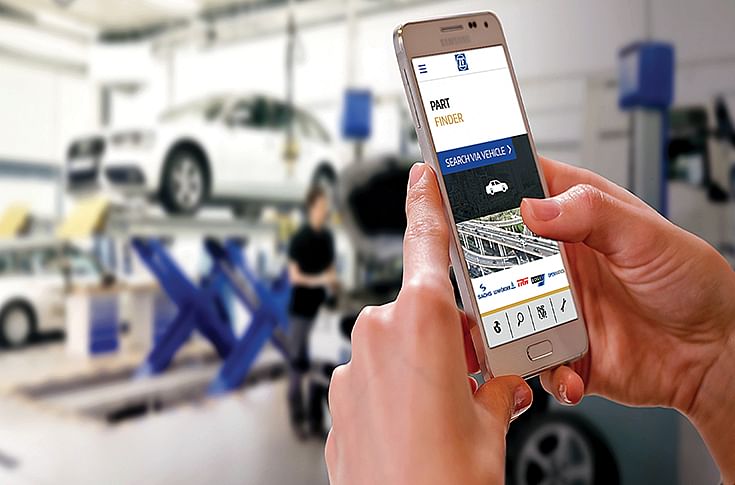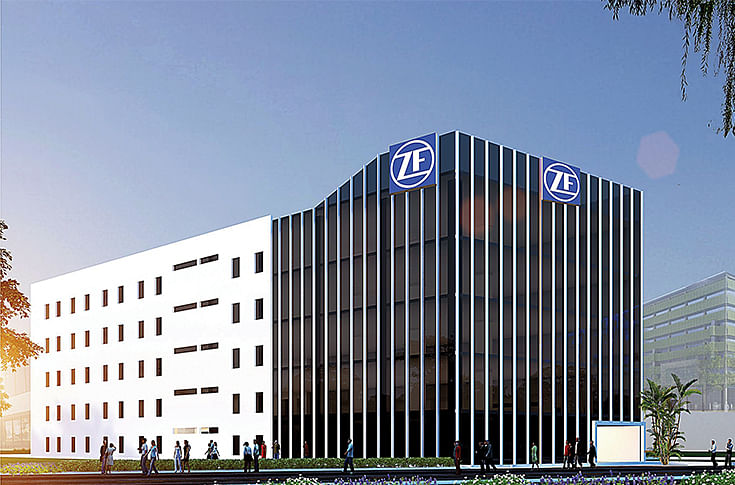Helmut Ernst: ‘ZF has decided that India, besides China and ASEAN, should be a hub on its own.’
How India can compete with China and why workshop training is the need of the hour.
The senior vice-president, ZF Aftermarket, ZF Friedrichshafen AG, spoke to Autocar Professional on the benefits arising out of TRW takeover, why India can compete with China, how megatrends like electromobility and autonomous cars could see OEs tie-up with independent aftermarket, and investing in workshop training as people will need very different skill sets in the future.
How would you define the transition after ZF took over TRW in May 2015 with the aftermarket divisions joining forces? Did that bring sharper focus on goals?
I would say that the ZF-TRW acquisition is like a marriage. A marriage is not over the day the ceremony is over, it instead begins that day. In partnerships, you don’t really change the other. You accept them and together work out the strengths. That is also the question of going together with TRW and ZF and, for us, it answers a lot of the questions from the aftermarket side also.
As we see, there is a change in the aftermarket whether it is through electric mobility or the changes that will come
with embracing autonomous driving cars. I see changes in India also via lot of legislations driving these changes that will result into more sensors and electronics in passenger cars.
A hundred years of ZF brought us to the point where we have leading precision in the drivetrain technologies. But what we missed was basically the chassis dynamics in the passenger cars. Our main aim is to see, think and act. So I would say that we were able to think and act but not able to see, which was filled in by the acquisition of TRW. If the group had decided to close that gap in terms of building new capabilities of our company by our own investments and hiring more engineers, it would have taken a minimum of 10 more years.
What I always say is you do not always invest in what later turns out to be successful. You also invest in things that may not be successful. But when you buy a company, you invest only in what is successful. So, the acquisition of TRW was an attempt to consolidate our global position without losing much time in the market.
Secondly, in the aftermarket when you put both the companies together, there is more or less no overlap. We have a very small overlap when it comes to products such as shock absorbers but even there the overlap is only in the product line but not in terms of where we are in the (global) markets.
While the brands that we have at ZF Aftermarket such as Sachs and Lemforder represent the upper premium brands, at TRW it was about more volume. So, basically when things were put together, it was really a perfect fit, and out of that it was clear for our employees also that this merger did not come as a misfortune to them but will give them an additional strength.

Reinforced by its new claim 'See. Think. Act.' ZF now offers a broad portfolio of intelligent mechanical systems which can address the challenges of future trends including digitalisation, electromobility and autonomous driving.
When I look back over the past two years or so, it involved a lot of work no doubt but it has paid off heavily for everyone, for the people and also for our customers. Mainly for customers, it is important that they see that we have a very convincing basket (of products), and there is no other supplier with such wide range of products to offer as what we have when it comes to chassis dynamics and other verticals.
Going back to where I started, you have to find the binding element if you really want to make it happen. And it is about the people and if the people will see that, it will work. If it only works on paper, you will fail.
How big is ZF Aftermarket in terms of business and headcount worldwide? How are you placed in CY2018?
We have close to 8,400 people in the aftermarket division. We drove a turnover of more than 3 billion euros (Rs 22,932 crore) in CY2017. We are shooting for more in CY2018 and that is very clear. The company as a whole drove turnover of about 36.5 billion euros (Rs 278,242 crore) in 2017.
We have about 650 certified service partners in the market and have more than 90 logistics locations as aftermarket globally. We also have 120 company-owned service places.
What was the growth rate for ZF Aftermarket in CY2017?
We recorded about 5-6 percent year-on-year growth if we look at the overall growth across the world (for aftermarket). We have seen some regions that recorded flat growth such as South America. As the business was growing back, we have been flat and yet we gained market share but you don’t see that in the figures.

Axial gen 3 EPS belt drive
We recorded small growth in North America at about 2 percent, registered about 3-4 percent growth in Europe, about 30 percent growth in China and also grew in India in double digits. The good thing is that in every part of the world, we are growing faster than the respective markets. That is what we are aiming for.
Who are ZF Aftermarket’s customers?
Our footprint in the aftermarket is the widest in the industry. We are present in the passenger cars and light commercial vehicles, trucks and buses, two-wheelers, off-highway vehicles, marines and wind segments. We are convinced that diversity gives us strength. When it comes to the independent aftermarket, we have some independent aftermarket players, which are specialists where we have a direct access. For most of the other independent aftermarket, we work as wholesalers. Within wholesalers, we have international buying groups.

Sachs CV damper and shock absorbers for passenger cars
As an aftermarket player we are also responsible for the original equipment suppliers (OES), where we are dealing with the OEs. Within OEs, we are dealing with CV manufacturers, mining and off-highway companies. Besides that, we have a small and serious OE business for customers – small automotive players, who do not have their own R&D. If they want to take a part from ZF Aftermarket that we have already developed off the shelf, we make those parts available, alongside providing them with the relevant technical expertise that they can use.
This is true for some of the new disruptive players, say in electric mobility. Let’s say there is a small company with 100 people that does not make all the parts on its own. They can use, for example, a chassis part that ZF has already developed and owns the IP right of, so that it becomes easier to build chassis systems and is quicker to the market. By doing so, a small company can save resources and money by not investing in engineering a part that’s capital intensive for a small volume of vehicles. In such cases, they need to get in touch with ZF and that comes under the domain of aftermarket for us. These are called special OEs.
Then we have service wherein we are dealing with our service partners. We are doing training, especially for new technologies such as electric mobility and connectivity in cars. While OEs and OEMs can train people in their workshops by themselves, but I think it is our duty to make sure that the products that we provide in the independent aftermarket are also provided for training purposes.
You said ZF Aftermarket has the widest portfolio in the industry covering passenger cars, two-wheelers, commercial vehicles, off-highway vehicles, rail and wind. Which amongst these is the largest business for the company in the aftermarket?
The biggest area is where you have the largest vehicle fleet, which is the passenger car segment. But CVs also contribute substantially to our aftermarket business. We have gearboxes and clutch systems, and we provide complete axles for buses. We are the global market leader when it comes to electric mobility in buses. We are starting a project in Europe currently to re-manufacture a diesel bus into an electric bus. We are doing this with a partner in the European market. This is something that won’t last long. After 10 years or so, new buses will be bought as electric buses. However, this model might work during this transition phase wherein conventional diesel buses can be converted to electric buses.
What, according to you, are the opportunities in India’s vast aftermarket?
India is one of our important markets. It is one of the fast-growing economies around the world. We see that India is really in a development phase now. I think India can be one country that can compete with China in terms of the growing economy. Secondly, we see the growing middle class. A lot of people are starting their own enterprises, we see increased private ownership of cars, which means there is adequate money. We have an overall car age of 7.5 or 7.6 years in India, if I am right. All these factors together mean that there is a healthy structure in the Indian market and this is a really good sign for the aftermarket business. We also see big spending on infrastructure.

Sachs clutch module.
Also, I think the (Indian) government has its interest in affordable mobility. Therefore, I think they will take care that they have good infrastructure for that. This will also help the independent aftermarket. Besides that, we have seen legal activities in order to make the roads safer as it wasn’t in the past. This connects directly with what we have as our biggest strengths in the company. I think India is the place to be in, no doubts about that.
If we want to safeguard that, we have to invest in people, in their mindset, in training and in knowledge of the people in the workshops because all the new parts will be increasingly complex. This is an area where the industry as a whole needs to invest.
We will see more electric vehicles arriving on the streets, although I have my doubts whether we will see this switch overnight. Firstly, we have an existing car parc, and the independent aftermarket is placed on the car parc and not on the new cars. That takes some time.
Fundamentally, the aftermarket business thrives on the number of times a vehicle comes to the workshop for maintenance or repair. When we talk about the transition from ICE vehicles to pure electrics, the number of moving parts is expected to sharply reduce in EVs. Will this impact the aftermarket segment as a whole? How is ZF Aftermarket looking at its own business model in such a scenario?
Of course that will impact the aftermarket segment, although I have my doubts on the changing business model. What is really going to change in this scenario is the absence of the motor (engine). When that is gone, you don’t need maintenance, this is very clear. But the tyres will stay just like the brakes, shocks and chassis parts and others. I can give you a new case study of a battery-powered car. They are sometimes heavier than the regular petrol car. This means that the shocks (absorbers) and the chassis parts may face faster wear and tear as compared to the petrol ones.

ZF has launched its Part Finder app in India with which customers can find the entire range of ZF Aftermarket spare parts from the Sachs, Lemforder, TRW and Boge brands.
If we are looking at, say, 2030, you might have 25 percent car parc as electric cars. But still the other 75 percent of the market will be the petrol or diesel cars. Therefore, I can say that there is a change, no
doubts about that. But let me tell you, we are prepared for that.
Besides electric mobility, there will also be a shift to autonomous cars and connected cars. If you speak to independent aftermarket people, you will know that in cases where a single person takes a decision on whether a repair (in the car) needs to be done or not, they generally try to drive more kilometres and postpone the repair.
In future, in connected cars, you won’t be able to do that anymore because then the car will diagnose on its own if a part has to be replaced. If you don’t follow what your car instructs you to do, you will lose your warranty. So this also means that the maintenance part will become much more difficult in the future as it is today.
If you check cars randomly on the roads today, in five out of every 10 cars, you will find that the maintenance is not properly done and that normally you would be required to do the maintenance check. So I would say that the independent aftermarket will change and it will be very alive in the future too.
However, I see that OEs will be getting impacted negatively. They are the ones who take care of the first three to four years of vehicle’s maintenance. They will be affected first and only then the aftermarket will see any impact. We will see a lot of the OE workshops closing down. Then in order to service cars everywhere (expansion of footprints), the OEs might tie up with the independent aftermarket.
So I guess we will see a shift from OE to the independent aftermarket, we will see a trend of OE players being part of the independent aftermarket for that reason. And while the overall maintenance of vehicles will go down slightly, we will have other activities that will come up.
India will see the implementation of BS VI emission norms from April 2020. Here, the aftermarket is largely unorganised, a large portion of workforce unskilled, and thrives on fake and cheaper parts. With vehicles becoming increasingly complex in the near future, it is clear that they cannot be fixed on the roadside in case of breakdowns. While we see that this will wipe out a large section of independent workshops and individual businesses from the unorganised aftermarket, do you foresee this transition as an opportunity area?
Yes, I see this as an opportunity. I also see that the independent aftermarket will become more professional, and will have training needs. May be we have to go a step further in India. However, what I am missing is a government-recognised or managed structured training of one or two years wherein people really learn what to do. To survive, if the government does not do this then they have to do this on their own.

In March 2018, the India Technology Centre in Hyderabad, which is deeply integrated with ZF's 20 main development centres globally, completed
a year of operations.
However, when I see with what speed India has been able to cover the challenges of digital environment, I would say so many people are working in that environment and this has happened in five to 10 years. So I think a smart country like India will be very easily able to do that. I mean the capabilities are there.
Can you throw some light on ZF Aftermarket’s 2025 strategy globally and where India stands in that?
Everything starts with the car parc. We check the car parc across different regions globally and then estimate the size in 2025, which we assume will double to what it is today. As partners to our customers globally, we have to put ourselves in their shoes and think about their priorities, which are quick deliveries, supply of right parts, easy identification of parts and the data.
Secondly, we want to have global balance wherein we say that we want to have one-third of our activities and the resources in Asia Pacific, one-third in North and South America and the remaining for Europe.
Therefore, we are steering that and building up our team and our business strategically in Asia Pacific. In Asia Pacific, we have different means of doing business whether we are in India, China or in ASEAN markets. Recently, the company has decided that India, besides China and ASEAN, should be a hub on its own. Basically, if you look at China, there you have a government-driven industry via government-driven regulations. India, on the other hand, is very democratic. There is a different way of doing business here.
Then, we are looking into the elements of digitalisation (connected cars) and e-commerce. In our 2025 strategy, we also have an element of training for ourselves because people will need very different skill sets in the future to what they have today. This is true especially for the aftermarket business, which is a people’s business.
For India, we will invest more than we have in the past especially in the aftermarket. That’s what I will be able to reveal right now.
(This article was first published in the June 15, 2018 issue of Autocar Professional)
RELATED ARTICLES
INTERVIEW: "EV Demand is Rebounding both in India and Around the Globe" - JLR's Rajan Amba
Jaguar Land Rover India MD Rajan Amba discusses the India–UK FTA, the company’s manufacturing plans, the upcoming Panapa...
TVS Celebrates 20 Years of Apache, Eyes Premium and Global Push
Marking two decades of its flagship performance brand, TVS Motor unveiled special anniversary editions on Saturday while...
Q&A: Mahindra's Nalinikanth Gollagunta on Upcoming Festive Season, 'Bold' Design Choices
Automotive Division CEO Nalinikanth Gollagunta says mid-teens growth is achievable with Roxx ramp-up, BEVs, and a resil...






 29 Aug 2018
29 Aug 2018
 15664 Views
15664 Views





 Prerna Lidhoo
Prerna Lidhoo


 Darshan Nakhwa
Darshan Nakhwa


